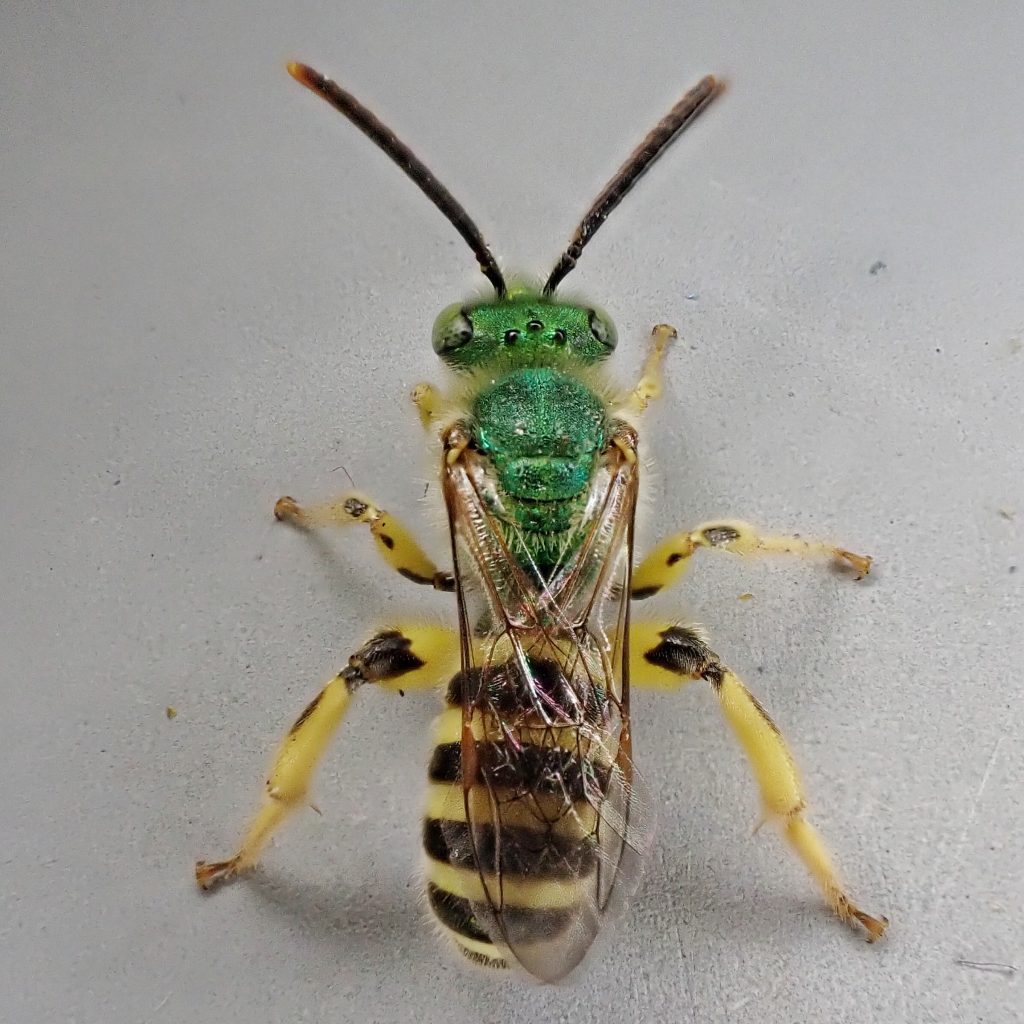
One hot day last August I was walking through the local cemetery looking for bugs and I saw several good sized, bright, shiny bees on a cultivated sunflower. I spooked most of them into flight whilst trying to get photos, but one of them came back. So I dug out my collapsible net and managed to capture it with a lucky swing. After a bit of refrigeration it allowed me to take a number of photos, and I was quickly convinced that it was an Agapostemon (commonly known as striped or metallic sweat bees; sweat bees are called that because they are attracted to the salts in our sweat; they can sting if threatened) because of the combination of a metallic green head and thorax, and striped abdomen. The striped abdomen, as well as the 11 flagella in the antenna, told me it was male.
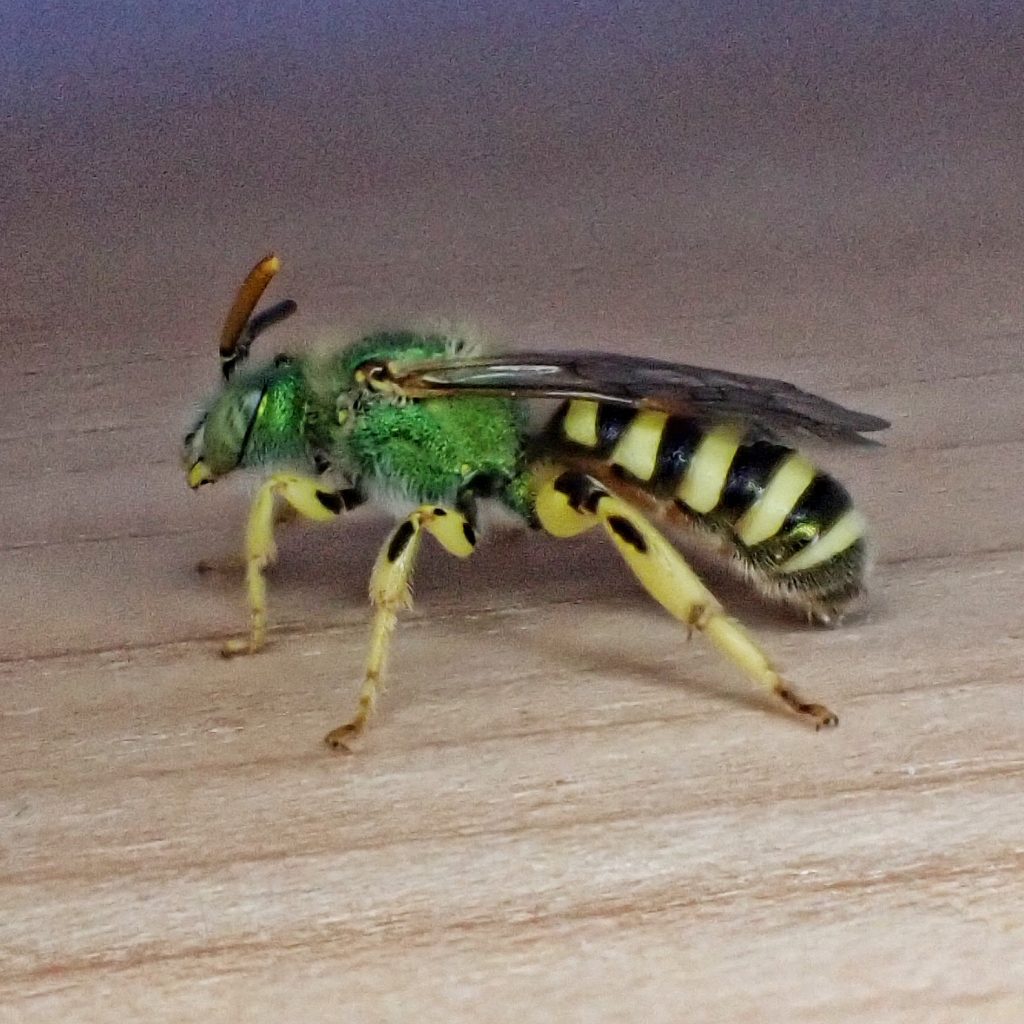
But after that I became confused, although my gut feeling was that this was A. texanus, because my inexperience led me to question whether the last two ventral segments of the abdomen would be considered to be brown or yellow, since they were brownish yellow. And then I made the mistake of conflating couplets of the key, thinking that the lack of a dark stripe on the rear of the hind femur meant that this could be A. virescens, when in actuality the lack of that stripe was only diagnostic within the group that had dark ventral abdominal segments. The upshot was that I moved on to other things. Some time later I saw that August Jackson, author of the very helpful e-book ‘The Bees of the Willamette Valley’, had included his email address in the booklet. And when I encountered these photos during my recent photo organization, I remembered that, and e-mailed them to him. He promptly, and graciously, replied that it was Agapostemon texanus because those ventral segments were much too light for A. virescens, and that my mystery stripe was irrelevant. So now I can actually talk to you folks about these very interesting sweat bees (family Halictidae), although first I must acknowledge my debt to Radclyffe B. Roberts for his outstanding and detailed paper “Bees of Northwestern America:Agapostemon ” (1973), which provided the key, as well as most of the information I will be attempting to convey.
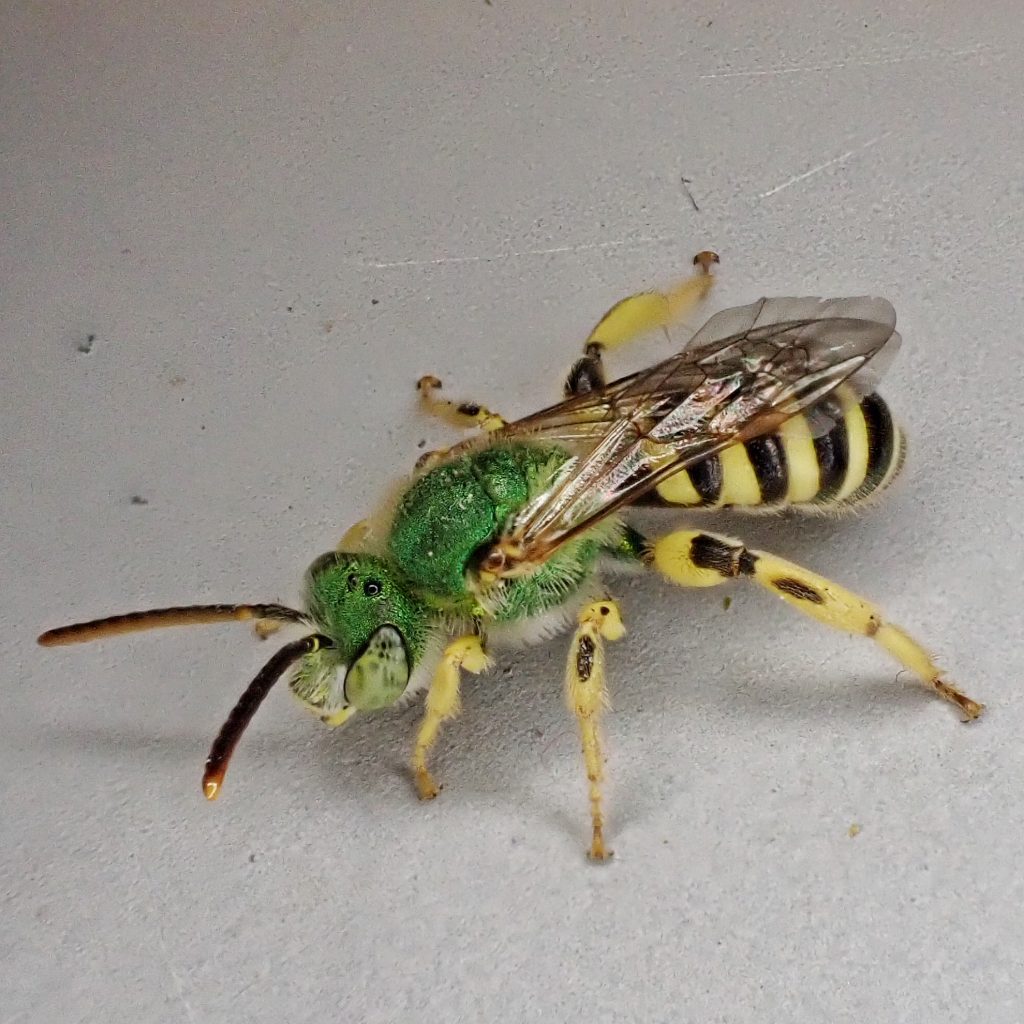
Texas Striped Sweat Bees have 2 generations per year. The fall/spring generation consists almost exclusively of fertilized females (only about 1 in a thousand males survive until spring, and it is not known whether the survivors overwinter as adults, pupae or larvae) who have spent the winter in hibernation. Shortly after emergence, and while feeding intensively and awaiting ovarian maturation, they begin constructing a nest, which is always done in bare, preferably loamy, dirt, in ground that can be anywhere from horizontal to vertical. Females searching for a nest site swing back and forth and fly very low to the ground. They land frequently, and seem particularly attracted to dark areas and small shadows, and therefore often build their nests under stones or leaves, or utilize existing openings in the ground, making their nest entrances hard to see.
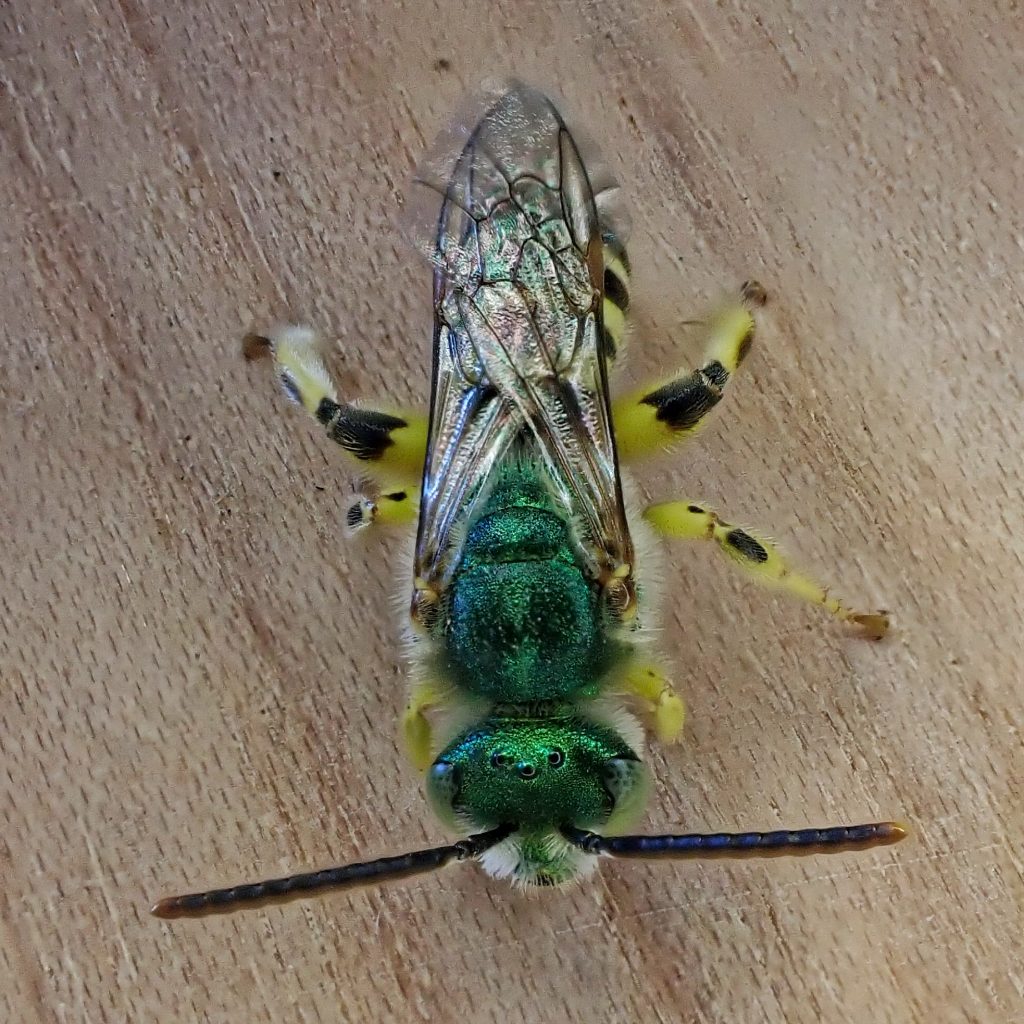
The main nest burrow is usually vertical (or sub-horizontal in sloped ground), is up to 5’ long, and just wide enough for the female to turn around in. Unlike most other Halictinae, Agapostemon sp. do not have a constricted entrance, although they do plug it from the inside at night. Lateral burrows are constructed from the main branch, are only as wide as the bee, extend sub-horizontally, are up to 8” long, and have a brood chamber at the end. These terminal cells are coated with a salivary secretion, and a single egg is placed inside, as well as pollen provisions for the larvae. They are then sealed with anal secretions, and the lateral tunnel is filled in by the diligent mother as she backs out of it. About 5 weeks later the new generation emerges from the burrow, by which time their mother has died.
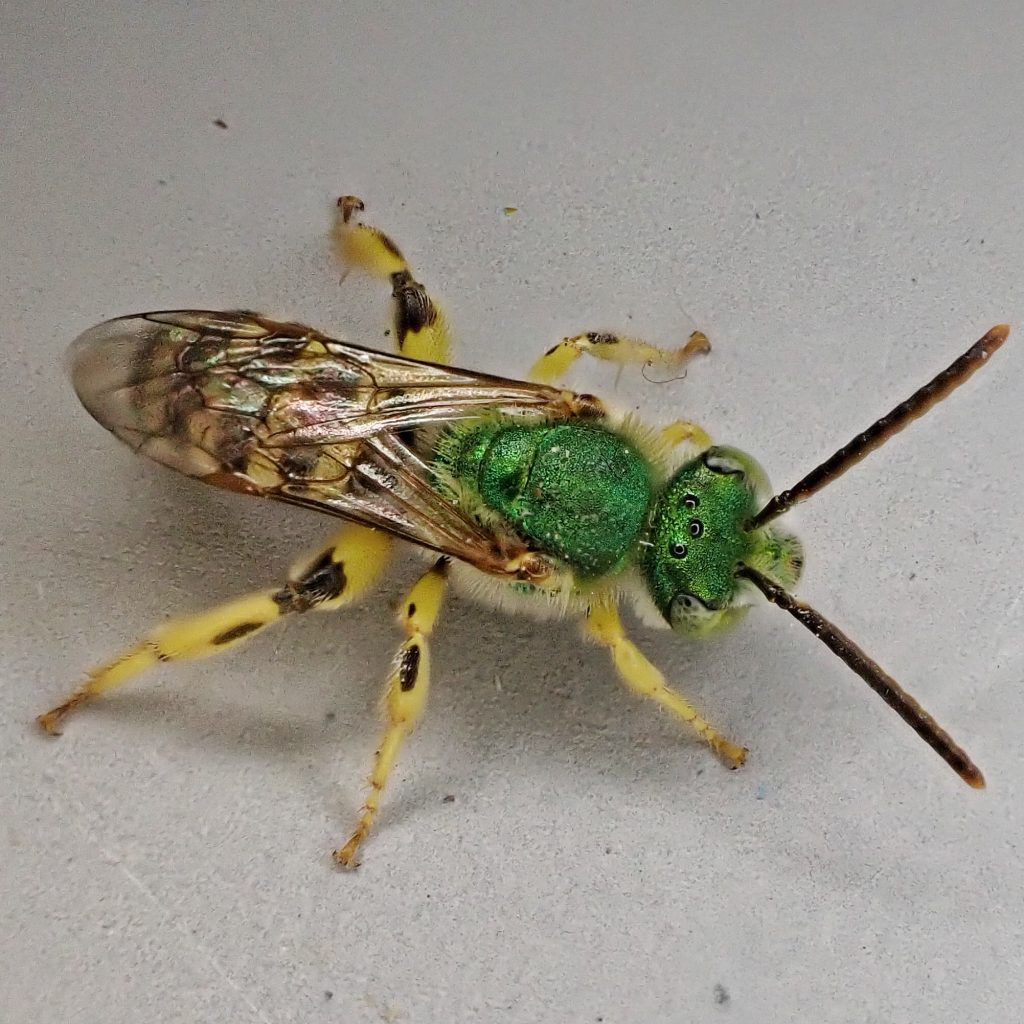
Here is where it gets really interesting. The summer generation of Agapostemon texanus is mostly diploid (two sets of chromosomes) females, because apparently the fertilized eggs of these bees are predominantly female. However, due to a lack of males, many of the females at this time produce unfertilized eggs, which do develop into adult bees, but predominantly results in haploid (one set of chromosomes) males. These males then spend all of their lives feeding at flowers and inseminating any females they can find. By staggering the sex ratio, females are never in competition with the males for food resources, both for themselves and for provisioning the brood cells, as well as not wasting energy by being pestered by males while they are trying to construct nests. Several off color remarks occurred to me while writing this paragraph, but I’ve decided to leave them to the imagination of my readers.
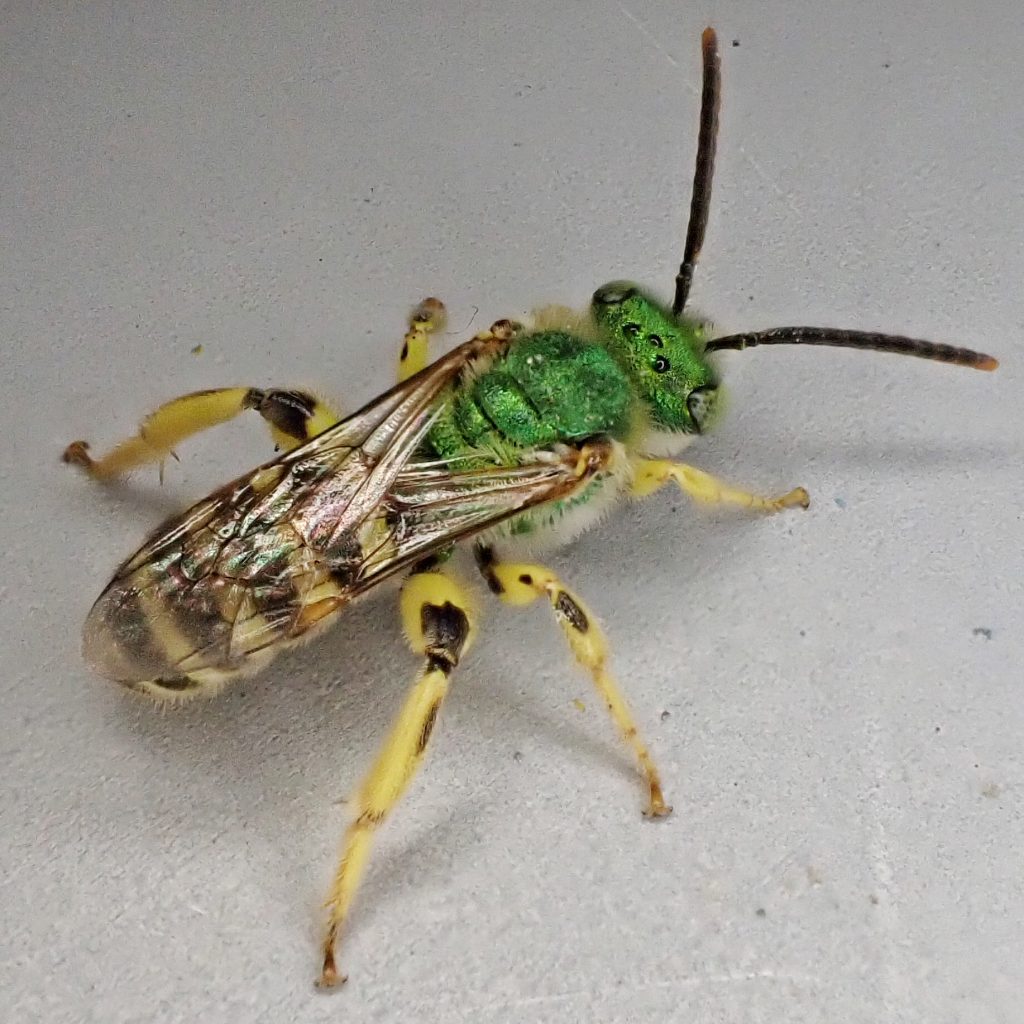
Description-Medium sized (9-11mm) bee with a metallic green or blue head and thorax, and three ocelli on top of the head; males have yellow and black banded abdomens, while the abdomen of females is the same metallic color as the thorax; females have two different sizes of punctures on their scutum; last two ventral segments of abdomen are yellow; hind tibia of males with either a dark longitudinal strip on the front, or no stripe at all.
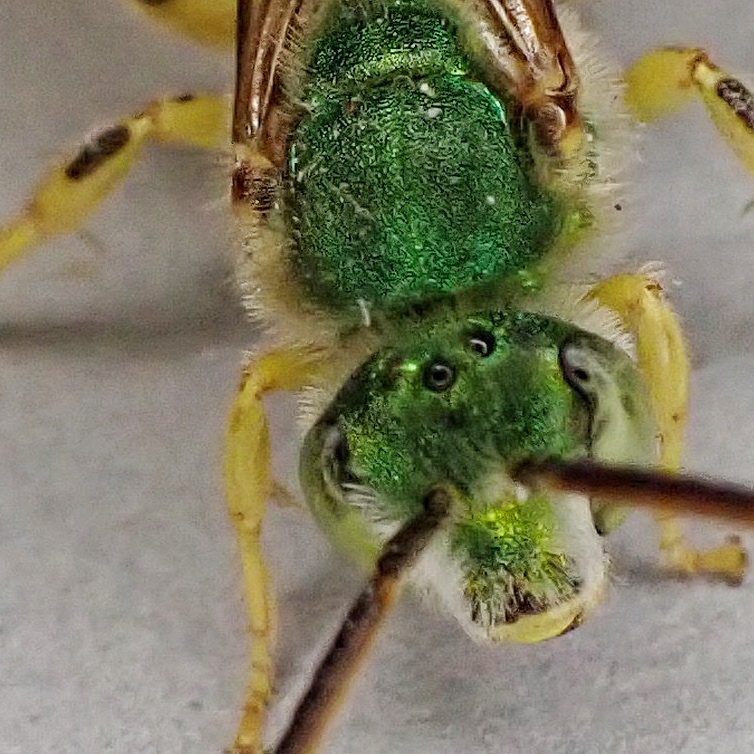
Similar species-Agepostemon in general can be distinguished from other North American bees by the presence of one or more of these features: a distinct keel around the rear of the propodeum (last segment of the thorax); 4 segmented tarsi on the hind legs of males; metallic green or blue head and thorax, in combination with a black, amber, or black and yellow metasoma (abdomen); Agapostemon angelicus males have a black stripe on the rear of the hind tibia, but never the front, and the females cannot be readily differentiated form those of A. texanus; Agapostemon virescens has dark brown or black on the last two ventral segments of the abdomen, and females have a black abdomen; other Agapostemon sp. best differentiated using microscopy and a key, such as the one found here.
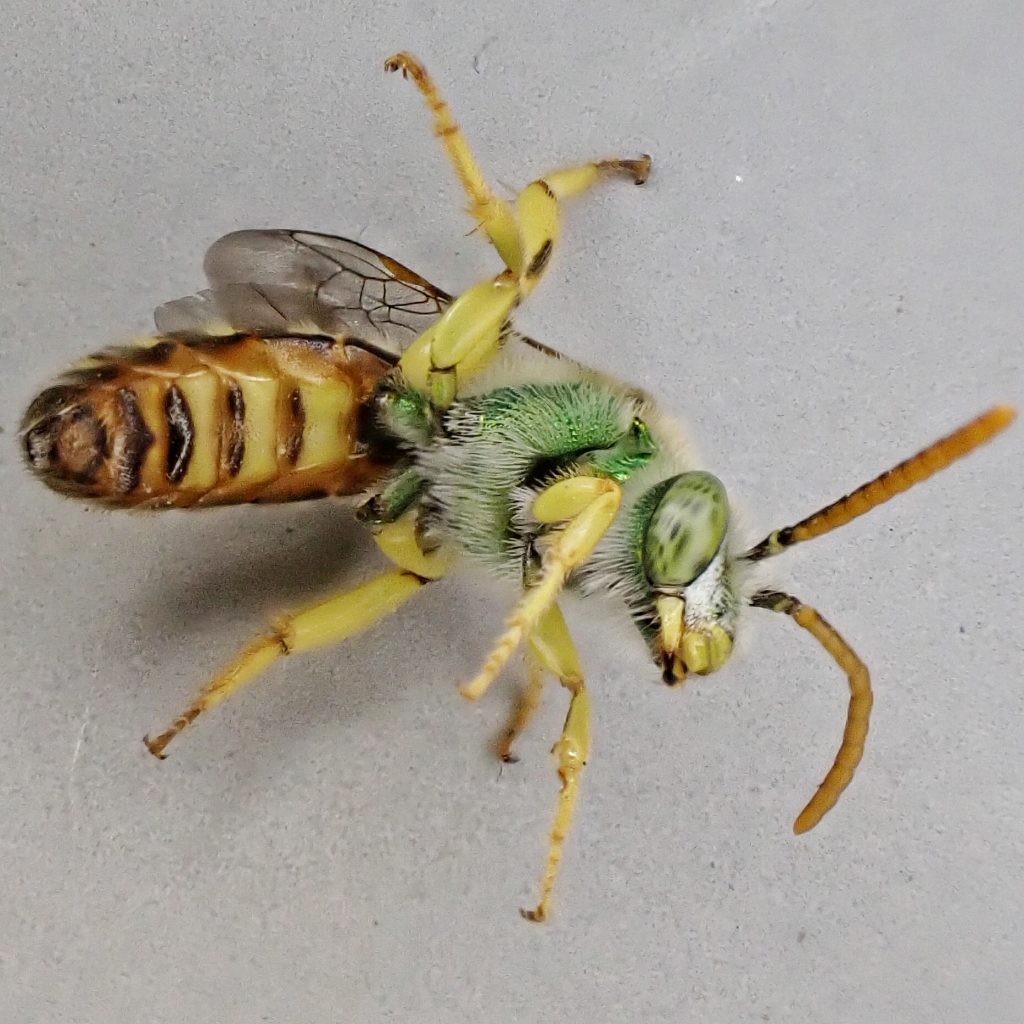
Habitat– Wherever there are abundant flowering plants, and at least some of them are blooming from May through September
Range-Found throughout North America; Region wide in appropriate habitat, except absent from the most arid and barren parts of the interior.
Adults active-April into June, mid July through September.
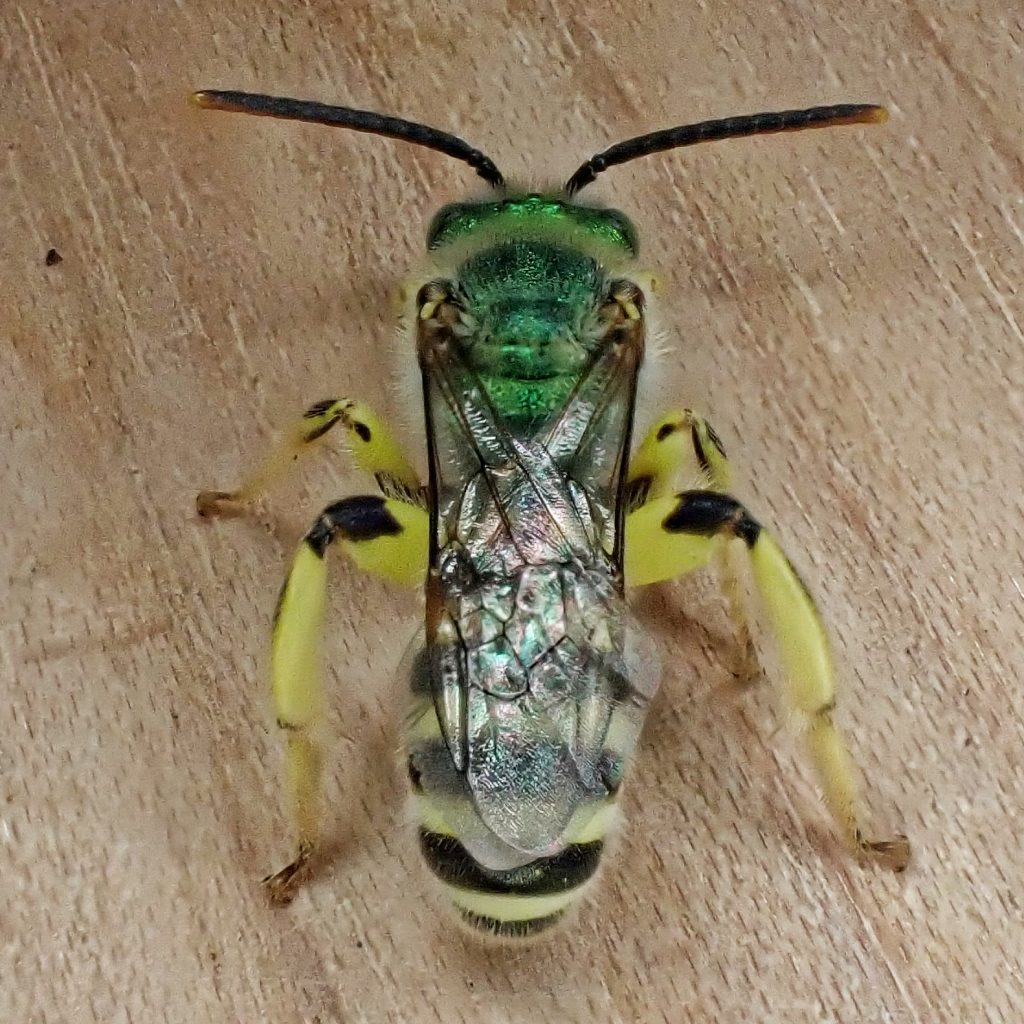
Eats-Nectar and pollen from a wide variety of plants, including but not limited to members of Asteraceae, Brassicaceae, Fabaceae, Rosaceae, and many, many others.
Eaten by-Cleptoparasitic Nomada sp. (Cuckoo bees), Sphecodes sp. (blood bees),and some phorid flies, will lay eggs in the brood chamber, and their larvae eat the larvae of the striped sweat bee, as well as its provisions; larvae of blister beetles attach to the females at flowers and are carried to the nest, where they consume the sweat bee larvae and its provisions; adults are prey for crab spiders, ambush bugs, robber flies, and sphecid wasps; conopid fly larvae of the genus Zodion are common internal parasites of Agapostemon adults, burrowing in from the metasoma.
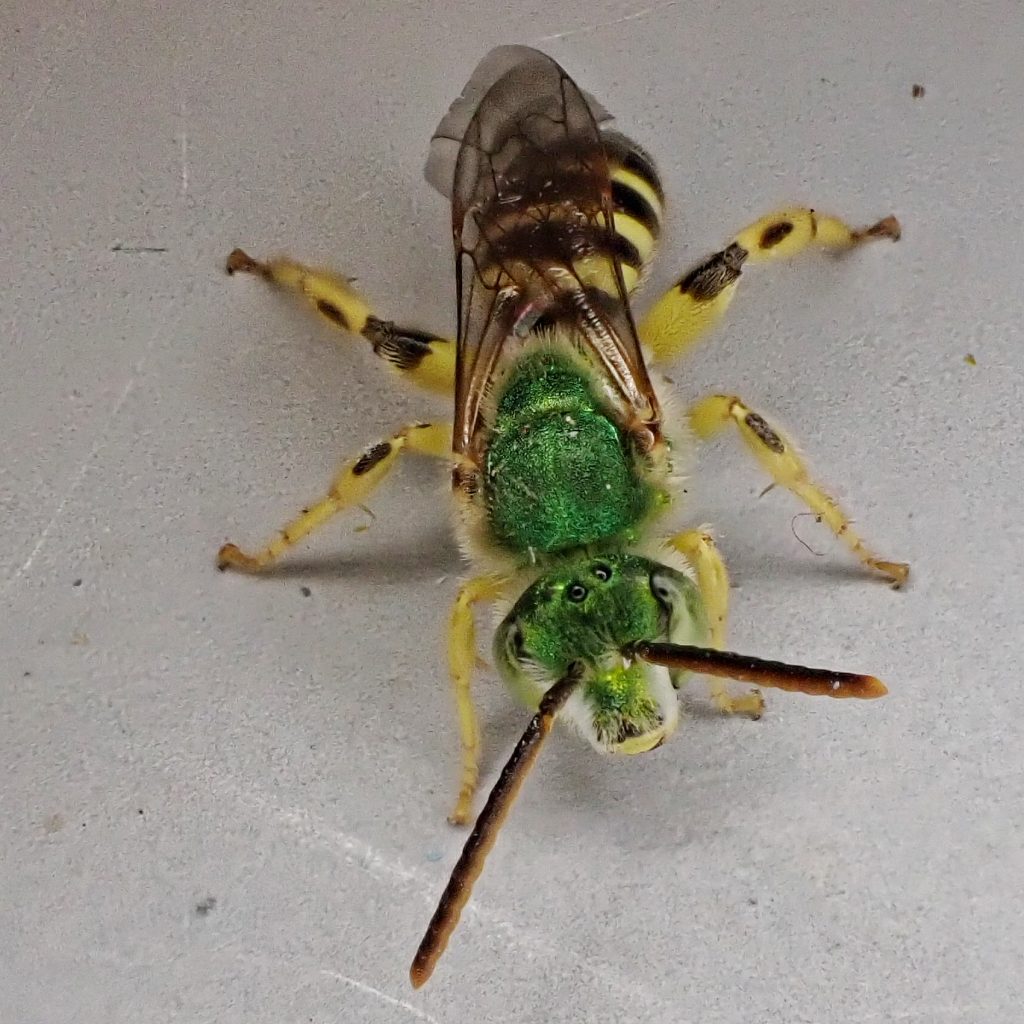
Life cycle-Bivoltine; usually a solitary nester, but exceptions have been found; nests in loamy soil, both horizontal and vertical; eggs are provisioned when oviposited; larvae take 30-35 days to reach adulthood; summer generation is mostly females and lives 2-3 months as adults, and fall/spring generation females live about 9 months, while the males usually only live until the first hard frosts.
Etymology of names–Agapostemon is from the Greek words for ‘stamen loving’ and refers to their pollen foraging needs, which also makes them a valuable pollinator. The specific epithet texanus refers to the type specimen having been found in Texas.
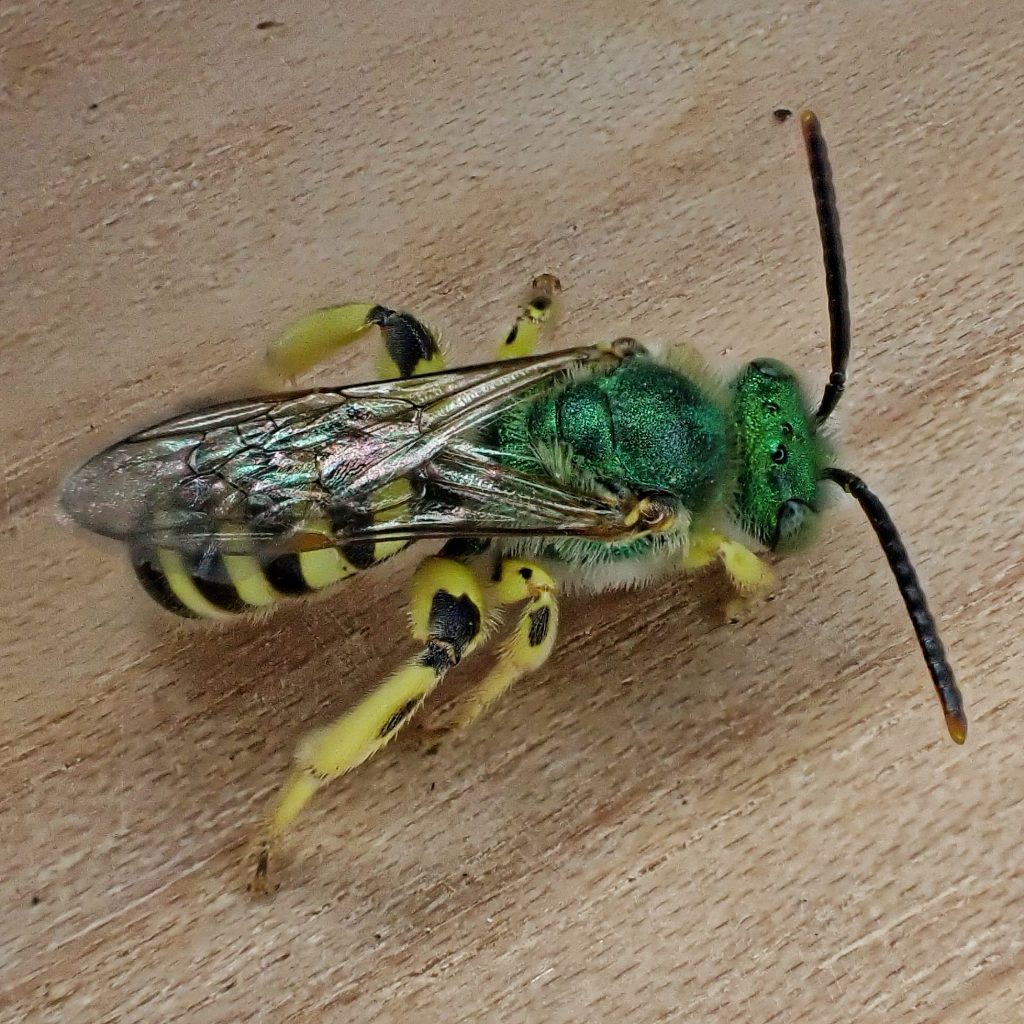
https://ir.library.oregonstate.edu/downloads/g732db41x
https://www.jstor.org/stable/25084166
https://bugguide.net/node/view/152767
https://www.discoverlife.org/20/q?search=Agapostemon+texanus
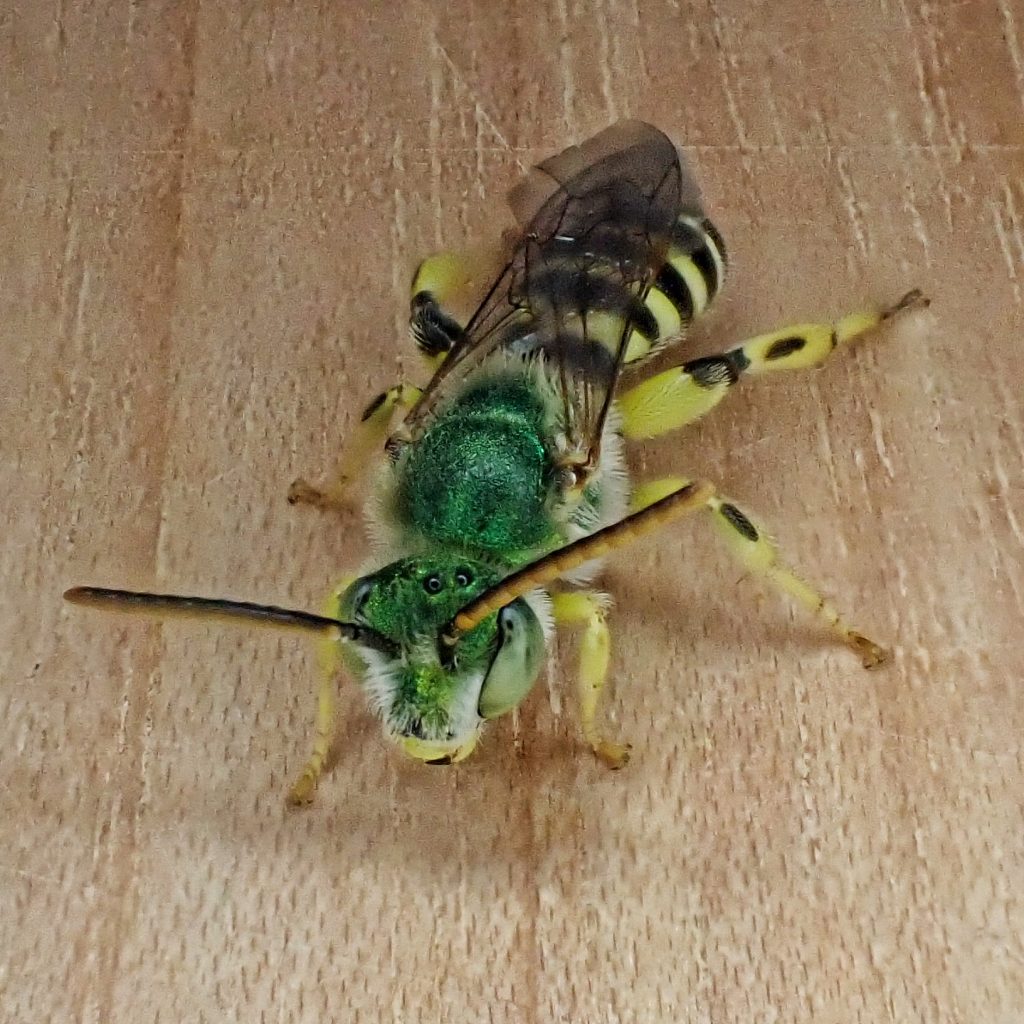
Very cool! Lemon/lime bees!
Also, I too had some off color thoughts about the staggered sex ratio. Thanks for writing about them!
Thanks, Morg!
Thank you for explaining why I have a plethora of striped abdomen Agapostemon in my yard whereas until early July nearly all were pure green! I’ve had a blast challenging myself to photograph them.
You’re welcome, Lisa! Glad it was useful! Thanks for your appreciation!